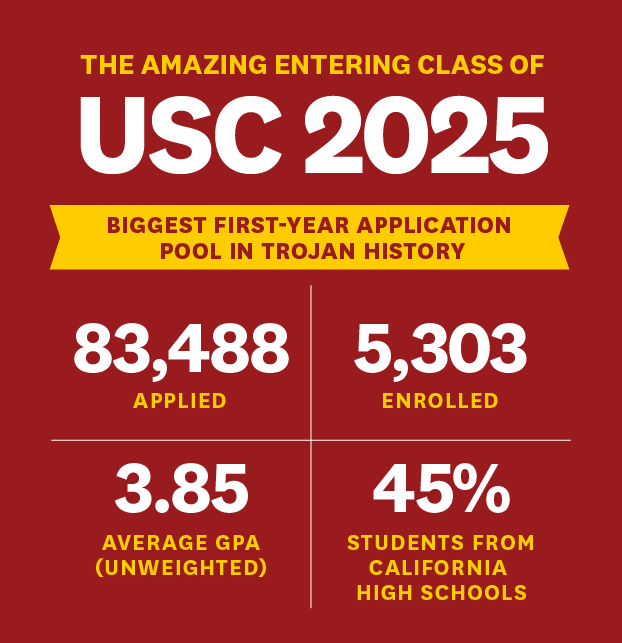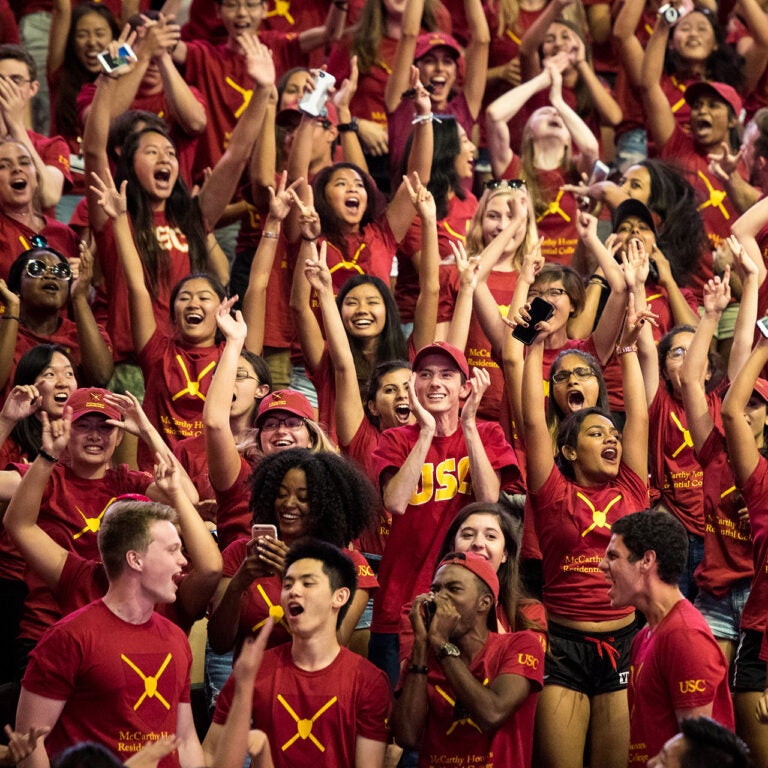USC’s incoming class includes 28% straight-A students, with an additional 11% of the students receiving only one B during their high school careers. (USC Photo/Gus Ruelas)
University
Impressive first-year class starts at USC after record number of students apply
New crop of Trojans includes transfers, rural and military students, and students from nearly every state.
With the start of the fall semester, USC has welcomed 5,303 new undergraduates to the Trojan Family. The entering class includes 3,759 first-year students selected from a record pool of 83,488 first-year applicants. It also includes a notable 1,544 transfer students — among the highest number of incoming transfer students across top private institutions.
“These new Trojans represent a remarkable cross section of students from a wide range of backgrounds who are exceedingly well-prepared for academic success,” said Timothy Brunold, USC’s interim vice president for enrollment management.

Among them is Alexis Jacquez, a first-year student at the USC Price School of Public Policy, who has dreamed of going to USC since she was a child.
“It’s a big deal that I got in,” said Jacquez, who graduated from Woodrow Wilson Senior High School in Los Angeles. “I worked really hard for it, and my family supported me all along the way. Everyone started jumping up and down and going crazy when I opened the acceptance email.”
Jacquez is one of 49 first-year Trojans who are members of the USC Leslie and William McMorrow Neighborhood Academic Initiative’s Class of 2025.
The seven-year program offers academic support and resources to prepare students from the neighborhoods closest to USC in South Los Angeles and the Eastside for the academic rigors of college, admission and graduation.
“Our scholars have done so incredibly well,” said Kim Thomas-Barrios, associate senior vice president of USC educational partnerships. “This truly shows that if children in any ZIP code receive the support, academic rigor and the means to acquire access, college is absolutely attainable.”
An expanding Trojan Family
Among the first-year and transfer students are those who have family members who attended USC, adding to the generations of Trojans who are connected by their USC education.
Max Lee, a first-year student at the USC Marshall School of Business, is following in the footsteps of his father, who earned his MBA at USC Marshall.
“I get to have the same experiences that he had,” said Lee, who grew up attending USC Trojan football games with his family. “My dad thinks USC was beneficial for his career and his future, so he’s hopeful that I take advantage of the same things that he did at USC to advance my career as well.”
“The Trojan Family is one of USC’s greatest strengths,” USC Interim President Beong-Soo Kim said. “With every class of entering students, we have thousands of students joining our Family for the first time while others are continuing a longstanding tradition – and all of them are tremendously accomplished and qualified. Our university has one of the world’s largest alumni communities — more than half a million across the globe — and we are fortunate that so many Trojans inspire a love for the university in their immediate or extended families.”
For these reasons, Kim has decided that, for the current admissions cycle, USC will not exclude information about whether an applicant has a relative who attended USC, but will instead continue its longstanding practice of considering that information as just one piece of an applicant’s overall experience, interests, and accomplishments. USC will share additional data about its admissions decisions consistent with California Assembly Bill 1780, which went into effect earlier this month.
“We want our classes to represent a very broad range of perspectives and experiences, from students who have never stepped on to our campus to those who have grown up visiting it. Both perspectives enrich our university, and we didn’t want to disadvantage one over the other,” Kim said. “Regardless of how they got here, students who come to USC are highly accomplished and ready for our academically demanding programs,” he added.
A vibrant mix of viewpoints
The first-year class includes 28% straight-A students, with an additional 11% of the students receiving only one B during their high school careers. On a 4-point scale, the group has a grade point average of 3.85 overall. “They are among the best and brightest students from their high schools,” Brunold said.
Students from California make up 45% of first-year enrollees; 195 of them attended a Los Angeles Unified School District high school. After California, the five states with the most first-year enrollees are New York, Texas, Illinois, Washington and New Jersey.
The new crop of Trojans also includes a significant number of students with military affiliation: 40 first-year students plan to participate in USC’s ROTC program. The new transfer class includes 83 students who are military-related: veterans, reservists or National Guard members.
First-year students came from 2,062 different high schools, with the most coming from the James A. Foshay Learning Center (Los Angeles), Mira Costa High School (Manhattan Beach), Loyola High School (Los Angeles), La Cañada High School (La Cañada Flintridge) Orange County School of the Arts (Santa Ana) and Milken Community School (Los Angeles).
The first-year class has about 30% more small-town and rural students than last year’s class — a total of 90 — which Brunold credits to USC being a part of the STARS (Small Town and Rural Students) College Network, an initiative to help students from small-town and rural America enroll in, succeed and graduate from the undergraduate program of their choice.
Brunold noted that bringing in students from so many different places creates “a community that doesn’t just have one viewpoint.”
“We’re getting students from all over who will enhance our campus through their varied beliefs, backgrounds and perspectives,” Brunold said.
‘At home already’
First-year student Rahul Keshav, an industrial and systems engineering major at the USC Viterbi School of Engineering, is one of the students who connected with USC through STARS.
“I’ve lived in a small town where when I go to the grocery store, every time I see someone there that I know,” said Keshav, who grew up in Half Moon Bay, a city of about 12,000 in San Mateo County. “This will be a new experience, and it’s a new community I’m excited to join.”
Now that he’s here, Keshav said he’s finding that community. “After a few weeks, I am so happy to have found good friends, great academic counselors and teachers that really care about my learning,” he said. “The community at USC is so welcoming. It has only been a short time here, but I feel at home already.”



